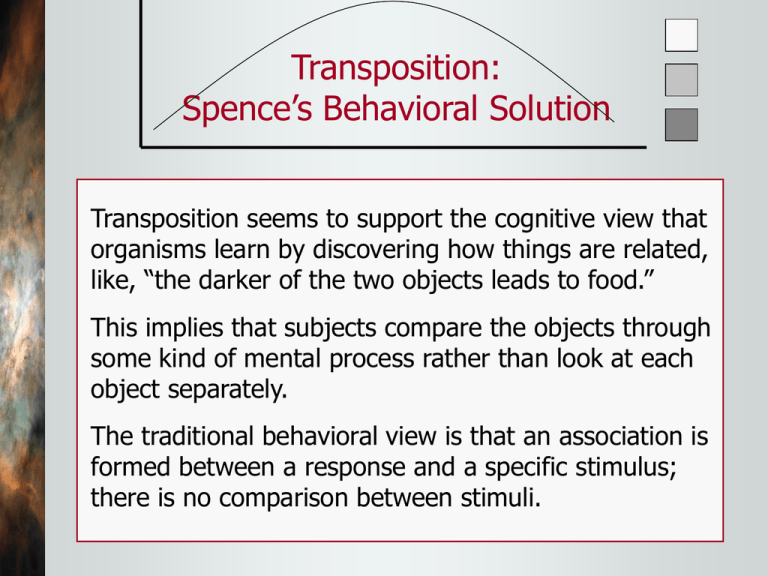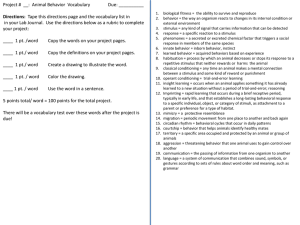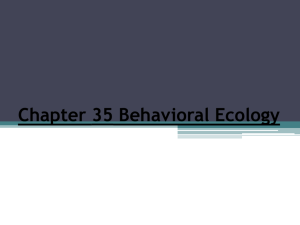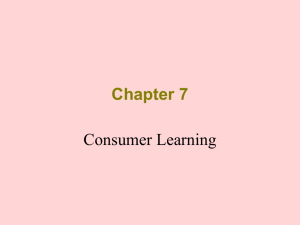Transposition: Spence's Behavioral Solution
advertisement

Transposition: Spence’s Behavioral Solution Transposition seems to support the cognitive view that organisms learn by discovering how things are related, like, “the darker of the two objects leads to food.” This implies that subjects compare the objects through some kind of mental process rather than look at each object separately. The traditional behavioral view is that an association is formed between a response and a specific stimulus; there is no comparison between stimuli. Transposition: Spence’s Behavioral Solution ? How can the apparent transposition (transfer) of a relationship be explained without assuming that the subject sees a relationship? Transposition: Spence’s Behavioral Solution Kenneth W. Spence developed a general theory of discrimination learning that not only explained transposition but revealed a shortcoming in cognitive theory. The theory used existing behavioral concepts: reinforcement, extinction, excitation, inhibition, and stimulus generalization. Transposition: Spence’s Behavioral Solution Reinforcement Reinforcing a response to a stimulus increases the tendency to respond to that stimulus again. This tendency is called excitation. Extinction Not reinforcing a response to a stimulus decreases the tendency to respond to that stimulus again. This reduced tendency to respond is called inhibition. Transposition: Spence’s Behavioral Solution Excitatory Stimulus Generalization After reinforcing a response to a stimulus, that response will tend to occur to similar stimuli. The greater the similarity, the stronger the response will be. Transposition: Spence’s Behavioral Solution Inhibitory Stimulus Generalization After extinguishing (not reinforcing) a response to a stimulus, that response will tend to be suppressed in the presence of similar stimuli. The greater the similarity, the strong the suppression will be. Transposition: Spence’s Behavioral Solution Excitatory Stimulus Generalization Let’s illustrate this process using a pigeon responding for food in an operant chamber: Pecks on the disk (or “key”) are reinforced on a VI schedule. The key is lit green. Transposition: Spence’s Behavioral Solution Excitatory Stimulus Generalization We then put the pigeon on extinction (no food for pecking). Every minute, we change the color of the key. The bird will peck thousands of times without food. We count how many responses are made to each color. Transposition: Spence’s Behavioral Solution Excitatory Stimulus Generalization Here is a graph that shows typical results: Number of Responses Wavelength Transposition: Spence’s Behavioral Solution Inhibitory Stimulus Generalization The pigeon receives discrimination training using the following stimuli: Discriminative Stimulus: White Triangle on Gray Background; VI reinforcement schedule. Delta Stimulus: White Triangle on Blue Background; no food (extinction). Transposition: Spence’s Behavioral Solution Inhibitory Stimulus Generalization We keep switching back and forth: The pigeons forms a discrimination, pecking a lot when the background is gray but pecking very little when the background is blue. Basically, “blue” means STOP. Transposition: Spence’s Behavioral Solution Inhibitory Stimulus Generalization Next, we put the pigeon on extinction—no food. The white triangle is projected on the key and we change the color of the background every minute. We count the number of pecks to the key in the presence of each color. Transposition: Spence’s Behavioral Solution Inhibitory Stimulus Generalization Here is a graph that shows typical results: Number of Responses Wavelength Transposition: Spence’s Behavioral Solution Application to Transposition Through stimulus generalization, the same stimulus may produce both excitation and inhibition. Will the subject respond or not respond to that stimulus? Spence assumed that the likelihood of responding could be estimated as follows: Excitation - Inhibition Here are some examples. Suppose that we have measured the amount of excitation and inhibition produced by each stimulus. Which stimulus is more likely to produce a response? Transposition: Spence’s Behavioral Solution Which Stimulus is More Likely to Produce a Response? Excitation = 7 Inhibition = 6 Excitation = 10 Inhibition = 4 Transposition: Spence’s Behavioral Solution Which Stimulus is More Likely to Produce a Response? Excitation = 10 Inhibition = 4 Excitation = 8 Inhibition = 1 Transposition: Spence’s Behavioral Solution Which Stimulus is More Likely to Produce a Response? Excitation = 8 Inhibition = 1 Excitation = 5 Inhibition = 0 Transposition: Spence’s Behavioral Solution The Transposition Experiment: Training Phase Excitation or Inhibition VS Brightness Dimension Which stimulus is more likely to produce a response? Transposition: Spence’s Behavioral Solution The Transposition Experiment: Test Phase Excitation or Inhibition VS Brightness Dimension Which stimulus is more likely to produce a response? Transposition: Spence’s Behavioral Solution The Transposition Experiment: New Test Phase Excitation or Inhibition VS Brightness Dimension Which stimulus is more likely to produce a response? Transposition: Spence’s Behavioral Solution Surprising Prediction Spence’s theory predicts that if the test stimuli are far away from the training stimuli, transposition will break down. The subject will choose the lighter of the two stimuli. Cognitive theory predicts that the subject will continue to choose the darker of the two stimuli. Spence’s prediction is confirmed! Transposition breaks down. A big boost for the behaviorists!







